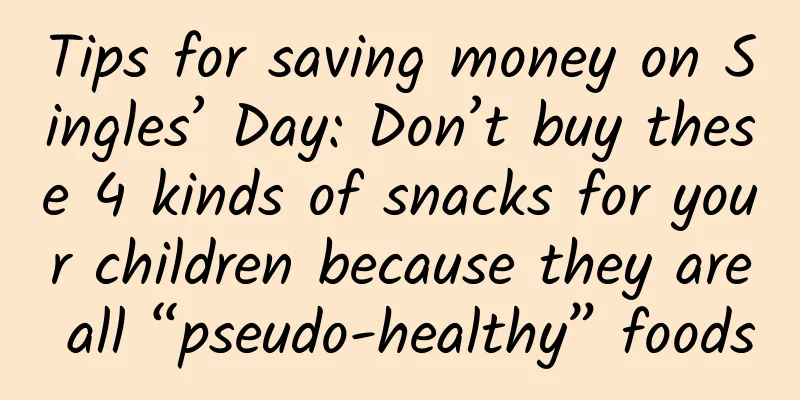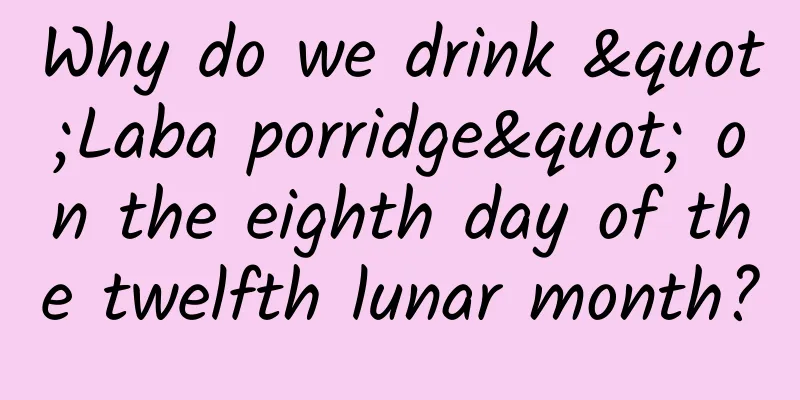Tips for saving money on Singles’ Day: Don’t buy these 4 kinds of snacks for your children because they are all “pseudo-healthy” foods

|
Although the prelude to Double Eleven has passed with great fanfare, the actual day has not yet arrived. I believe many people are waiting for the big move. They have saved up a lot of coupons, just waiting for the time to come, to make a big splash! Those who don’t have children buy for themselves, and those who have children buy for their children. Most parents’ shopping carts are filled with “good things” prepared for their children! However, the bigger the promotion, the higher the risk of paying the IQ tax! Let’s take a look at the four “pseudo-healthy” foods that experts have weeded out. It’s not too late to remove them from your shopping cart! 01 Yogurt: One bottle and four sugar cubes Tuchong Creative Mom: "Do well in the exam. If you get first place, I'll buy you a box of yogurt as a reward!" Child: "Thank you, Mom, you are so kind!" Most parents think that yogurt and other drinks are healthy. After all, it has the word "milk" in its name, and milk is nutritious, which is equivalent to giving children calcium supplements. In fact, yogurt is the chief representative of "pseudo-healthy" foods! Drinking a box of yogurt is equivalent to giving children 16g of sugar, which is about 4 sugar cubes if converted into sugar cubes. I believe that no parent would agree to let their children eat 4 sugar cubes at a time. Image source: e-commerce platform Image source: e-commerce platform According to national requirements, the order of ingredients in a list must be written from most to least[1]. The first ingredient in this yogurt is water, not milk, and fructose syrup and white sugar are also added. The Chinese Dietary Guidelines recommend that daily added sugar intake should be below 25g[2]. If you give your child yogurt as a reward, he or she will easily drink one or two boxes, and the sugar intake will easily exceed the standard. Excessive intake of added sugar by minors can cause many direct and indirect harms to their physical and mental health: 1. Increase the risk of dental caries; 2. Not only is it high in calories, it also stimulates appetite, causing you to eat more and induce obesity; 3. Causes blood sugar to rise and increases the risk of diabetes; 4. People who often drink sweet drinks will refuse to drink plain water; 5. Prefer sweet snacks, which affects the eating of regular meals and leads to malnutrition. This breast is not that breast. For the sake of your child's health, it is better to touch it as little as possible. 02 Plums: Eating one bag will give you 9.5g of salt Tuchong Creative Many parents think that candied fruits are made from natural fruits, have a sweet and sour taste, and can provide some nutrition for children. However, a lot of sugar and salt are added to this kind of food during the processing. Because the sweet and sour taste is more prominent, you can't taste the obvious saltiness, but the salt content is really not low. The following figure shows the ingredient list and nutritional composition table of a certain brand of preserved plums: Image source: e-commerce platform From the ingredient list, we can see that table salt is located just behind the fruit itself and white sugar, which shows that a lot of salt is added. Image source: e-commerce platform 1g of salt equals 400mg of sodium. The nutritional composition table of this snack shows that the sodium content is 3171mg/100g. Divide this sodium value by 400 to get the salt content. So the salt content of this plum is: 3171÷400≈7.9g of salt. According to the net content of a pack of 120g, eating all of it is equivalent to taking in 9.5g of salt. The Dietary Guidelines for Chinese Residents recommends that the daily salt intake per person should not exceed 6 g[2]. This is equivalent to eating a beer bottle cap (without the rubber pad inside) or a bag of preserved plums. Not to mention children, even adults would exceed the daily salt intake limit. If children are given this kind of food frequently, it is not only bad for their health, but also affects their eating habits: eating these salty and sweet heavy-tasting foods frequently will make them lose interest in light and natural foods, leading to partial eclipse, picky eating, and malnutrition. Over time, it will also increase the risk of chronic diseases such as high blood pressure and high blood sugar in adulthood. In addition, excessive sodium intake will also lead to increased calcium loss in children's bodies, causing calcium deficiency, affecting bone development, and even increasing the risk of osteoporosis in adulthood. 03 Dried vegetables: lack of water-soluble vitamins Cannot replace vegetables Tuchong Creative It is a common problem for children not to like eating vegetables, so parents often think of giving their children dried vegetables as a supplement, thinking that it is equivalent to eating vegetables. In fact, this type of dried vegetables cannot replace vegetables, because after the vegetables are dehydrated and made into dried vegetables, almost all water-soluble vitamins are gone, especially heat-sensitive vitamin C and bioactive ingredients. In addition, the fat content and calories of this type of dried vegetables are not low, especially fried dried vegetables. For example, the following picture: Image source: e-commerce platform From its nutritional composition table, we can see that the fat content is as high as 41.5 g/100 g and the calories are as high as 557 kcal/100 g. The "Dietary Guidelines for Chinese Residents" recommends that the daily intake of cooking oil is 25 to 30 g [2] and that vegetables should be eaten 300 to 500 g per day. If dried vegetables are used instead of vegetables as a supplement for children, the fat intake will almost reach more than 120 g, which is more than 4 times the recommended amount in the guidelines. Excessive fat intake will increase the risk of obesity in children. If your child doesn't like to eat vegetables, it is recommended that parents change the way they cook them, such as chopping them into vegetable meatballs or making vegetable soup. If your child really wants to eat dried vegetables, choose the "freeze-dried" type. 04 Orange Juice: Cannot Replace Fruit It will only make the sugar level exceed the limit Tuchong Creative Similar to the idea of "replacing vegetables with dried vegetables", many parents will "make up" for the missing nutrition of their children who don't like to eat fruits through various fruit juices. But in fact, fruit juice drinks such as Orange Juice and even homemade juice cannot replace fresh fruits. Image source: e-commerce platform From the ingredients list of this orange juice drink, we can see that water and fructose syrup account for the largest proportion; although the juice content is marked as no less than 10%, in fact it is not much higher than 10%; the orange pulp content is marked as 5.5 g/100 ml. If a bottle is 500 ml, you will only eat 27.5 g of orange pulp. However, the "Dietary Guidelines for Chinese Residents" recommends that the daily intake of fruit is 200 to 350 g [2]. If you use Orange Juice to replace fruit, it is far from enough. If you really eat 200 g of orange flesh by drinking Orange Juice, that means you have to drink 3636 ml. Let's not talk about whether you can drink it or not, drinking 100 ml will consume 9.7 g of sugar. The sugar intake is already exceeded after drinking 500 ml, let alone 3636 ml. If you really want to drink juice, it is recommended to buy 100% original juice. Our country stipulates that the ingredient list of 100% original juice can only contain water and juice[3]. For example, the following one: Image source: e-commerce platform Minors are in the stage of growth and development, and their daily diet should adhere to the principle of "comprehensive and balanced nutrition, reliable and safe sources". Take the "pseudo-healthy" foods mentioned today as an example. They either have excessive sugar and salt content or simply cannot cover the daily nutritional needs. Frequent consumption will also affect their eating habits, so it is recommended that parents must exclude them from their children's dining tables and daily diet lists. If you want your children to grow up healthily and strongly, you can supplement their balanced diet with milk, fresh fruits and vegetables, and nuts in moderation, and it is better to eat less other snacks. References: [1]. GB 7718-2011 National Food Safety Standard General Rules for Labelling of Prepackaged Foods [2]. Chinese Nutrition Society. Dietary Guidelines for Chinese Residents. People's Medical Publishing House. 2016 [3].SB/T 10197-1993 General technical conditions for raw fruit juice Author | Xue Qingxin, member of Chinese Nutrition Society, registered nutrition technician, health manager, public nutritionist Review | Gao Chao, Associate Researcher, Institute of Nutrition and Health, Chinese Center for Disease Control and Prevention This article is produced by the "Science Rumor Refutation Platform" (ID: Science_Facts). Please indicate the source when reprinting. The pictures in this article are from the copyright gallery and are not authorized for reproduction. |
<<: Russian chocolate is all made in China? Don’t say anything if you don’t understand!
Recommend
Alibaba Cloud: PolarDB database will set new TPC-C global double chart records with 2.055 billion tpmC performance in 2025
Recently, Alibaba Cloud announced that the Alibaba...
How did Panda Mini Class gain nearly one million fans through fission?
Knowledge payment has been very popular in recent...
Make money and support the boat. Intraday small wave operation method. Futures course
Make money and raise a boat. Introduction to the ...
Analysis of "HEYTEA" growth strategy!
Growth Effect Store size: At the end of 2018, the...
China's "first long text goblet" was unearthed in Yunmeng, Hubei!
In September 2020, the Hubei Provincial Institute...
This is the first time I heard that the stars can be observed during the day! On the 27th, let's enjoy the fairy tale of the stars and the moon together
Original title: A "starry fairy tale" d...
Community Operation SOP Methodology
From my own perspective, I sorted out my understa...
Should you upgrade your iPhone to iOS 10?
[51CTO.com Quick Translation] iOS 10 looks good, ...
up to date! Data rankings of 59 information flow advertising platforms!
The following is the latest traffic ranking of 59...
Worth collecting: The most complete product operation knowledge framework
Why do operations What is Operations? If you can’...
How to create tens of millions of daily active users? Share 7 major operation strategies!
When judging whether a product is well made, the ...
7 tricks to plan a creative information flow that will create a hit
In the closed loop of information flow promotion ...
Review丨Mafengwo’s 25 million operating activities, is it worth it?
On December 12, 2017, Mafengwo announced the comp...
Record low-quality videos and upload them to major paid course platforms to earn income. Everyone can do it with low threshold
I have previously shared projects about recording...
Chinese jailbreakers, start running tonight
iOS 9 is officially released Tonight, hundreds of...









